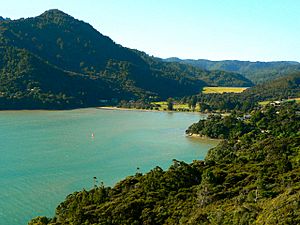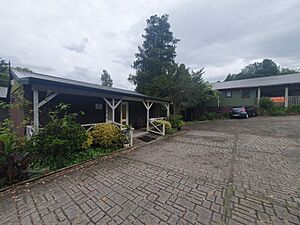Huia, New Zealand facts for kids
Quick facts for kids
Huia
Te Huia
|
|
|---|---|
|
Settlement
|
|

Looking north-west from Huia look-out over Huia bay towards the Lower Huia Dam.
|
|
| Country | New Zealand |
| Region | Auckland |
| Ward | Waitakere ward |
| Local board | Waitakere Ranges |
| Electorates |
|
| Area | |
| • Total | 3.49 ha (8.62 acre) |
| Population
(June 2023)
|
|
| • Total | 680 |
|
|
||
Huia is a small coastal town in West Auckland, New Zealand. It is part of the beautiful Waitākere Ranges Regional Park. Most of the homes in Huia are found along Huia Road, which curves around Huia Bay and goes west towards Little Huia.
Nature and Landscape
How Huia's Land Was Formed
Long ago, huge forces deep within the Earth pushed up the Waitākere Ranges and caused the Manukau Harbour to sink. The Huia Creek and its valley likely formed along a crack in the Earth's crust from this event. After the last ice age, when sea levels rose, the river mouths in West Auckland filled with water. Because there wasn't much sand in the Manukau Harbour, places like Huia became tidal mudflats.
Plants and Wildlife in Huia
The Huia area is mostly covered by a warm lowland forest with many pūriri trees. Along the western shores of Huia Bay, you can find a special coastal forest with different types of pōhutukawa and rata trees. This unique ecosystem is home to many native birds, insects, bats, and lizards. Local groups, like the Huia Trapping Group, work to protect these animals by removing pests, helping New Zealand reach its goal of being Predator Free by 2050.
History of Huia
The Name Te Huia
Huia was originally known as Te Huia. It is believed the area was named after a Waikato Tainui chief, Te Huia. He used to live in the area during certain seasons but loved the bay so much that he decided to stay there permanently. A longer traditional name for the place is Te Rau-o-te-Huia, which means "The Plumes of Te Huia." The plumes also represent his pride in the location. People used "The Huia" until the 1970s, but now "Huia" is more common. Shells found at Hinge Bay show that Tāmaki Māori people lived in Huia from at least the year 1520.
Early European Settlers and Logging
In 1853, the Gibbons family from Newfoundland arrived in Huia. They set up a mill to cut down kauri trees. The Karamatura Stream, west of Huia, was one of the first streams in the Waitākere Ranges to be dammed for kauri logging. Later, the Marama and Kakamatua streams were dammed in the 1860s, and the Huia Stream in the 1870s. The Gibbons family were joined by William and Mary Kilgour, who started a farm, and the Foote family, who were also relatives from Newfoundland.
Building the Dams
Work on the Upper Huia Dam began in 1924. This led to more houses being built for the workers' families. Materials for the dam were brought by boat to Huia, then moved by a special tramway to the dam site. The Upper Huia Dam was finished in 1929. After it was built, many families who worked on the dam left the area. The tramway continued to be used until the 1960s. The Lower Huia Dam was built next to the town in 1971. Both dams are important for supplying water to Auckland and are managed by Watercare Services.
Huia as a Holiday Spot
After the Upper Huia Dam was built, Huia became a popular place for people to go on holiday and for retirees to live. As the Huia valley grew back with trees, people started wanting to turn the ranges into a regional park. The Centennial Memorial Park, which later became part of the modern Waitākere Ranges, opened in 1940. By the 1960s, Huia was also known for its community of artists and poets.
People of Huia
Population Overview
Huia is a rural settlement that covers about 3.49 square kilometers. In the 2023 New Zealand census, Huia had a population of 675 people. This was an increase of 36 people since the 2018 census. The median age in Huia was 43.4 years. About 19% of the people were under 15 years old, and 16% were 65 or older.
| Historical population | ||
|---|---|---|
| Year | Pop. | ±% p.a. |
| 2006 | 546 | — |
| 2013 | 591 | +1.14% |
| 2018 | 639 | +1.57% |
| 2023 | 675 | +1.10% |
Ethnic Groups and Languages
Most people in Huia identify as European (Pākehā). There are also people who identify as Māori, Pasifika, and Asian. English is spoken by almost everyone in Huia. A small number of people also speak the Māori language or other languages. About 20% of the people in Huia were born outside New Zealand.
Things to See and Do
Local Businesses and Parks
Alfreds Huia Store is the only local general store and cafe in Huia. It first opened way back in 1886. On the shores of Huia Bay, you'll find Huia Reserve. This park has picnic tables, a BBQ, a small playground, a basketball half-court, and a half-pipe for skating. It's also close to the Lower Huia Dam, Upper Huia Dam, and Karamatura Falls.
Museums and Learning
The Huia Settlers Museum opened in 1984. It is located near the entrance to Karamatura Park. Inside, you can see many old tools and items from the kauri logging days. It also has artifacts from the shipwreck of HMS Orpheus. Another interesting place is the Jonesonian Institute, a small and unique museum and art gallery in Huia.
Outdoor Adventures
There are many walking tracks and beaches around the Huia area. You can explore these trails and enjoy the natural beauty. The highest point in the Waitākere Ranges, Te Toiokawharu (474 meters), can be reached by the Twin Peaks Track, which is part of this valley.
Community Services
The Auckland Council offers several places to stay in the area, including the Kiwanis Huia camp, Huia Lodge, Barr cottage, and a camping area called Barn Paddock. Huia Lodge used to be the Huia Schoolhouse from 1894 to 1961. The local high school is Green Bay High School. Huia has a volunteer fire brigade that helps the communities of Cornwallis, Huia, and Whatipu. This brigade has 17 volunteers and a fire truck and a medical response van. The residents of Huia are also supported by the Huia-Cornwallis Community Group. This group manages the Huia Hall and plans many community events throughout the year.


